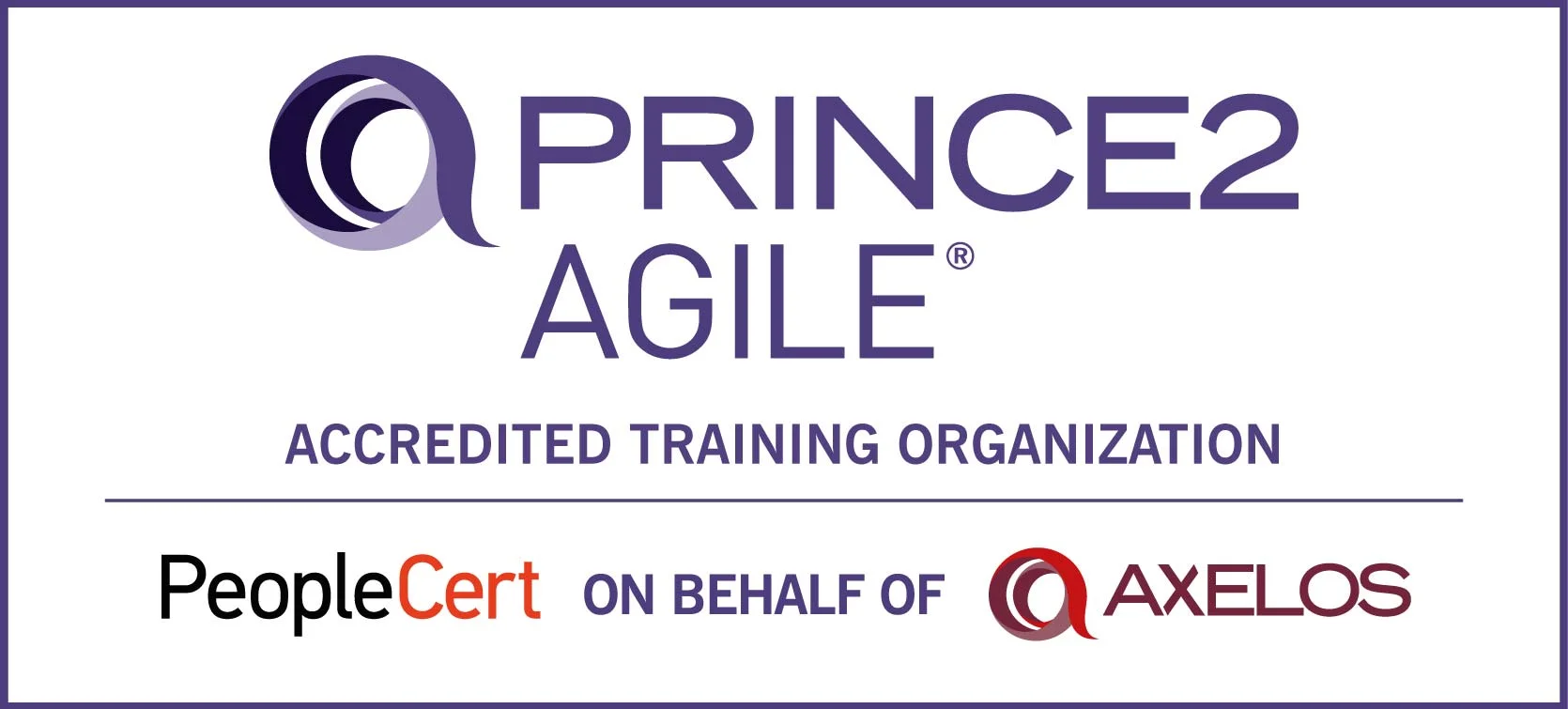Amazon Aurora is cloud-based relational database from Amazon combines the simplicity and cost-effectiveness of open-source databases with the performance and availability of traditional enterprise databases.
Let’s get into depth:
Aurora features an efficient storage subsystem that boasts high performance. The database engines, compatible with MySQL and PostgreSQL, have been tailored to make optimal use of this rapidly distributed storage. The storage capacity expands automatically based on requirements, with an Aurora cluster volume able to scale up to a maximum size of 128 tebibytes (TiB).
Additionally, Aurora streamlines and standardizes the complex tasks of database clustering and Aurora replication, addressing traditionally challenging aspects of database configuration and administration. It provides high performance and availability with up to 15 low-latency read replicas, point-in-time recovery, and continuous backup to Amazon S3, and replication across three availability zones.
It's five times faster than a standard MYSQL database and three times faster than traditional PostgreSQL databases. It obtains the security, availability and reliability of saleable databases at 1/10th the cost. Amazon Relational Database Service contains Amazon Aurora. It automates time-consuming administration tasks like hardware provisioning, database setup, patching and backups.
Amazon Aurora DB clusters
AmazonAurora DB clustersinclude one or more DB instances and a cluster volume that manages the data for those DB instances. AnAurora ClusterVolumeis the virtual database storage volume that distances with multiple availability Zones, with each one having a copy of the DB cluster data. Here, you also need to focus onDB cluster vs DBinstance. Following are the two types of DB instances that make up an Aurora DB cluster.
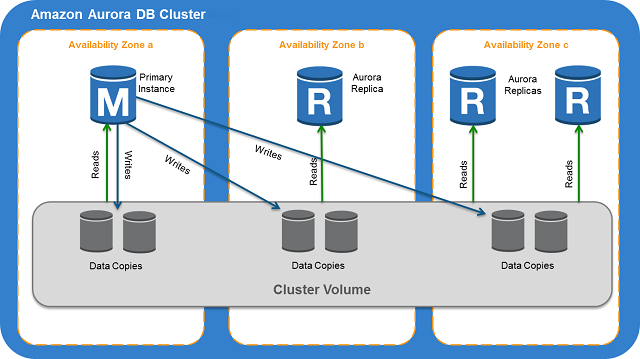
- Primary DB Instances:Supporters read and write operations and perform all of the data modifications to the cluster volume. EachAurora DB clusterhas one primary DB instance.
- Aurora Replica:It connects to the same storage volume in the same way as primary DB instances and supports only read operations. Each one can successfully have up to 15 Aurora Replicas in addition to the primary DB instance. Maintains the high availability by locating Aurora Replicas in separate availability zones. Aurora can specify the failover priority for Aurora Replicas. It can offload read workloads from the primary DB instances.
For theAurora Multi-MasterCluster, all of the DB instances have the read and write capability. So, in this situation, the distinction between the primary instance and Aurora Replica doesn’t apply.
For discussing replication topology where, the clusters can use either single master or multi-master replication, known as writer and reader DB instances. The following illustrates the relationship between the cluster volume, the primary DB instances and Aurora Replicas in anAurora DB cluster.
For allAurora clusters, the preceding information, which uses single master replication, is applicable. These include provisioned clusters, parallel query clusters, global database clusters, server-less clusters, and all MQ SQL5.7-complete and Postgre SQL companionable clusters.
Aurora Clusters uses theAurora Multi-Masterreplication to have a different arrangement of read-and-write and read-only DB instances. All of the DB instances available in the multi-master cluster can perform the write operations. There are not any single DB instances which perform all write operations, and there are not any read-only DB instances.
It elaborates that the terms Primary instance and Aurora Replica do not relate to multi-master clusters. Here, it is essential to understand the clusters that might use Multi-masterAurora replicationare referred to as the DB instances and reader DB instances.
TheAurora Clusterelaborates on the separation of computing capacity and storage. Let’s understand this with an example. An Aurora Configuration with only an individual DB instance is still a cluster because of the fundamental storage volume involving multiple storage nodes distributed across multiple availability zones.
Advantages of Amazon Aurora
- High Performance
Power performance-intensive applications and critical workloads simultaneously maintain full compatibility with MySQL and PostgreSQL at 1/10th the cost of the commercial databases. Here, you can quickly scale your database deployment up and down from the smaller to more significant instance types as per your requirements, which change frequently for you. To scale up the read capacity and performance, it would be great to add up to 15 low-latency read replicas across the three availability zones. It increases storage as needed up to 128TB per database instance.
- High Availability and Durability
It develops applications with Multi-AZ availability backed with a 99.99% uptime SLA and globalAurora replicationwith cross-region disaster recovery within 1 minute. Amazon RDS continuously monitors the health of the database and underlying the Amazon Elastic Compute Cloud instance. It also includes fault-tolerant and self-healing storage, Aurora Global Database, etc.
It is designed for the highest availability and fault tolerance and replicates the six copies of the data across the three availability zones. It also supports continuous backup of the data to Amazon S3. Even if any failure occurs, then Aurora automatically detects the fault and recovers from most database failures with minimal downtime.
- Highly Security
Amazon Aurora brings multiple levels ofsecurityfor the databases to make them better, among others. On the encryptedAmazon Aurorainstance, data within the underlying storage is encrypted by the management with the help ofAWSkey management service and encryption of data in transit with SSL. Also, there are automated backups, snapshots and duplications within the same cluster.
It supports encryption at rest in transit. Data is encrypted with the help of keys. It brings the network isolation with the Amazon VPC, allowing you to control access to your database instances.
- MySQL and PostgreSQL Compatible
The database engine of Amazon Aurora is highly compatible with existing MySQL and PostgreSQL open supply databases, and it also adds compatibility for brand-new releases often.
It also showcases that you will easily migrate MySQL or PostgreSQL databases to Aurora victimization standard import/export tools and snapshots. Besides this, it also suggests that the code, drivers, applications and tools you can already use altogether with the existing databases might be used withAWSAurorawith less or without any modification.
- Fully Managed
Amazon Aurora, administered through Amazon Relational Database Service (RDS), is entirely managed, alleviating the need for concerns related to tasks like hardware provisioning, software patching, setup, configuration, or backups. Aurora consistently monitors and backs up your database to Amazon S3, facilitating precise point-in-time recovery.
Monitoring database performance is simplified through options such as Amazon CloudWatch, Enhanced Monitoring, and Performance Insights, a user-friendly tool designed for prompt identification of performance issues.
- Support for Migration
With compatibility with MySQL and PostgreSQL,Amazon Auroraemerges as an attractive choice for migrating databases to the cloud. If transitioning from MySQL or PostgreSQL, refer to our migration documentation for a comprehensive list of tools and options. For migrations from commercial database engines, theAWSDatabase Migration Service offers a secure migration process with minimal downtime.
Features of Amazon Aurora
- It helps in Parallet Query:
Amazon Aurora Parallel Query enhances analytical queries' speed compared to existing data, potentially accelerating queries by up to two orders of magnitude while maintaining high throughput for core transactional workloads.
By shifting query processing to the Aurora storage layer, it gains substantial computing power while minimizing network traffic. With Parallel Query, users can concurrently run transactional and analytical workloads within the same Aurora database.
- It brings Server-less configuration and custom database endpoints:
AmazonAurora’s Serverless configuration allows the database to start up, shut down, and dynamically adjust capacity based on application requirements. This setup enables users to run their database in the cloud without the hassle of managing specific database instances. Furthermore, custom endpoints empower users to distribute and balance workloads across different sets of database instances.
For example, users can provision a group of Aurora Replicas utilizing an instance type with higher memory capacity for running analytics workloads. A custom endpoint facilitates directing the workload to these appropriately configured instances while isolating other instances.
Amazon Aurora Use Cases
- Mobile Gaming
With Amazon Aurora, high-demand applications can be effectively implemented, and future expansions can easily be accommodated. The absence of licensing constraints makes it an ideal choice for accommodating the variable usage patterns typical of these applications. Specifically, web and mobile games designed to operate on a large scale necessitate a database solution that offers high throughput, extensive storage scalability, and robust high availability features, all of whichAmazon Auroradelivers.
- Software as a Service
Amazon Aurora brings the features in the managed database offering, which helps SaaS businesses concentrate on developing high-quality applications without worrying about the underlying database that powers the applications. These applications mostly use multi-tenant architectures, which need to have a deal of flexibility in instance and storage scaling along with high performance and reliability.
- Enterprise Applications
Amazon Aurora is an excellent choice for any enterprise application which can use the relational database. As compared to the commercial databases, Amazon Aurora can further help cut down front user database costs by 90% or more, simultaneously improving the reliability and availability of the database. Being in a fully managed service helps users save time by automating time-consuming tasks that include provisioning, patching and backup, failure detection, recovery and repair.
Businesses that use Amazon Aurora
- Samsung: Samsung moved over a billion operators across three continents from Oracle toAmazon Auroraby enhancing inactivity and scalability while depressing monthly costs.
- DoorDash: DoorDash makes use of Amazon Aurora to help it make over 800,000 deliveries a day, managing billions of rows and around 10TB of data in a singleAurora Cluster.
- The Pokemon Company:Amazon Aurora allows Pokemon to support 300+ million operators, which involves 300 login requests per second while automating administrative tasks.
- Dow Jones:Dow Jones roamed its market data service from the on-premises database to Amazon Aurora ahead of schedule and with no interruption to service.
Conclusion:
As a result, Amazon Aurora stands out as one of the first cloud-based relational databases capable of combining open-source simplicity and cost-effectiveness with enterprise performance and availability. Its key features include efficient storage subsystems, automatic scaling based on demand, streamlined database clustering, and replication.
With compatibility for MySQL and PostgreSQL, Aurora ensures high performance and availability, offering up to 15 low-latency read replicas, point-in-time recovery, continuous backups, and replication across multiple availability zones. The Multi-Master Cluster option further enhances write capabilities. High performance, availability, durability, security, and compatibility are all managed through Amazon RDS.
Significant businesses like Samsung, DoorDash, The Pokemon Company, and Dow Jones have successfully leveraged Amazon Aurora, attesting to its ability to handle diverse workloads with efficiency and scalability. A fully managed, feature-rich, and cost-effective cloud computing solution, Amazon Aurora is ideal for a variety of applications and enterprise needs.
👉 Start your journey with Amazon Aurora today.
Author Details

Mr.Vikas Sharma
Principal Consultant
I am an Accredited ITIL, ITIL 4, ITIL 4 DITS, ITIL® 4 Strategic Leader, Certified SAFe Practice Consultant , SIAM Professional, PRINCE2 AGILE, Six Sigma Black Belt Trainer with more than 20 years of Industry experience. Working as SIAM consultant managing end-to-end accountability for the performance and delivery of IT services to the users and coordinating delivery, integration, and interoperability across multiple services and suppliers. Trained more than 10000+ participants under various ITSM, Agile & Project Management frameworks like ITIL, SAFe, SIAM, VeriSM, and PRINCE2, Scrum, DevOps, Cloud, etc.
Confused About Certification?
Get Free Consultation Call

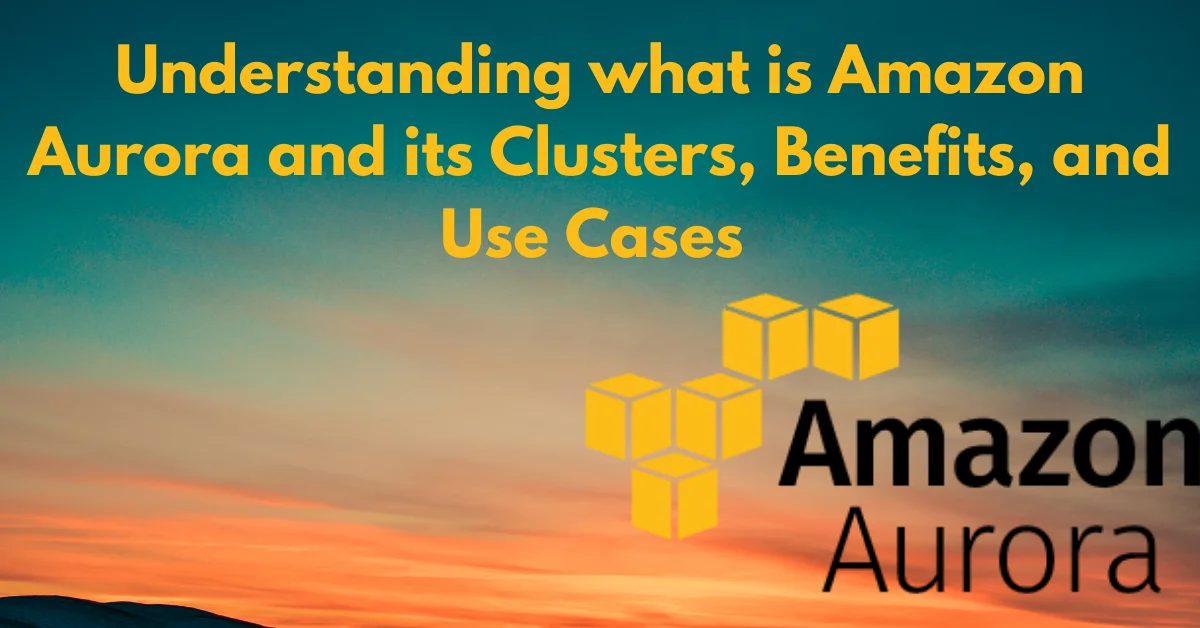
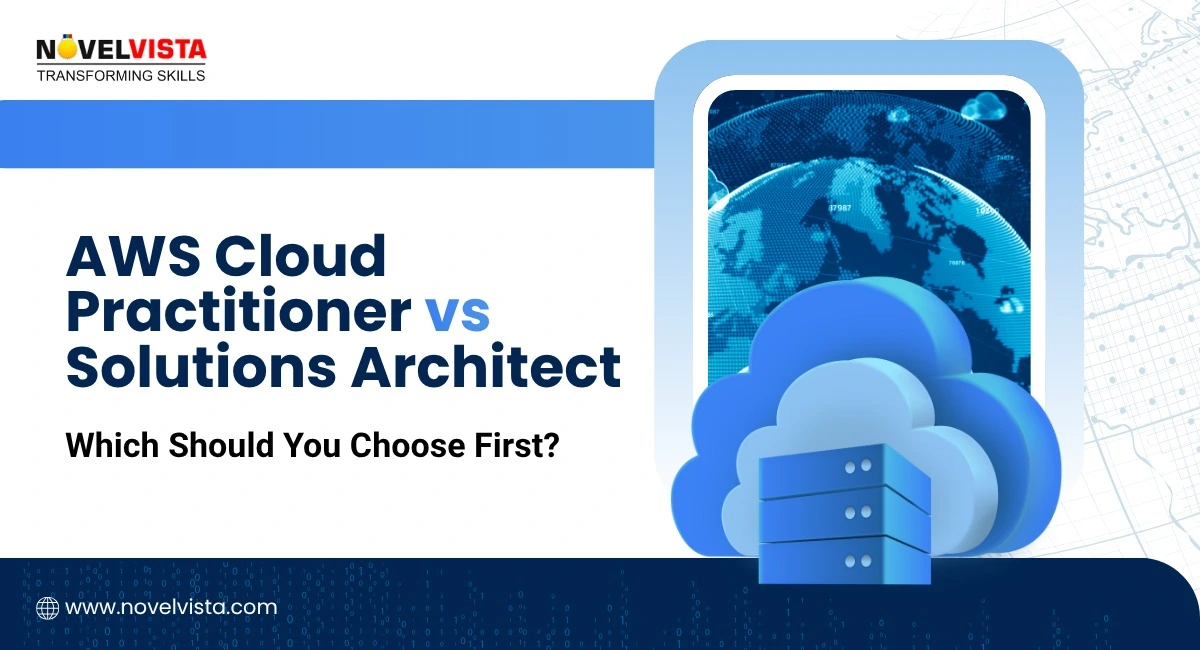
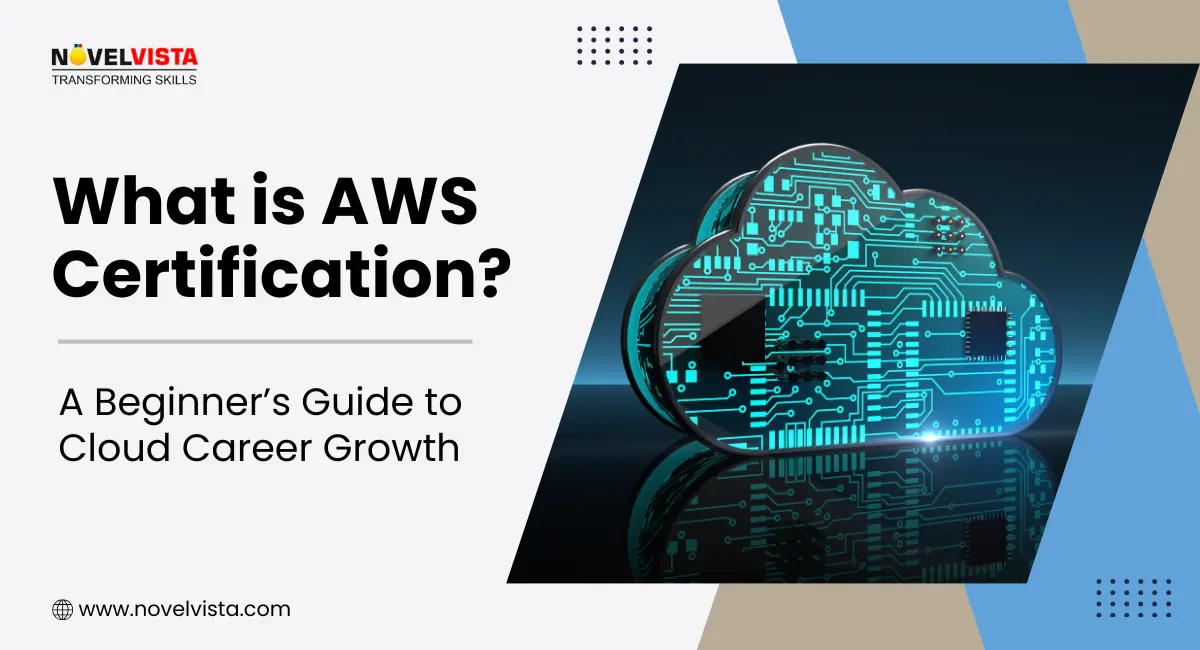
![Free AWS Solutions Architect Associate Practice Exam: No Signup, Instant Results! [Hands-on Prep] | Novelvista](https://www.novelvista.com/resources/images/blogs/other/aws-solutions-architect-mock-exam-featured.webp)

